Sandra Day O'Connor, 1st woman on Supreme Court, dies at 93
Retired U.S. Supreme Court Justice Sandra Day O'Connor, who forged a path for women in the law, championed ideological compromise and educated generations of Americans about the rights and duties of citizenship, has died.
The court announced her death in a statement Friday morning, citing "complications related to advanced dementia, probably Alzheimer's, and a respiratory illness." She was 93.
O'Connor was the first woman to serve on the nation's highest court, shattering two centuries of male-dominated jurisprudence with widely-celebrated poise, humanity and independence.
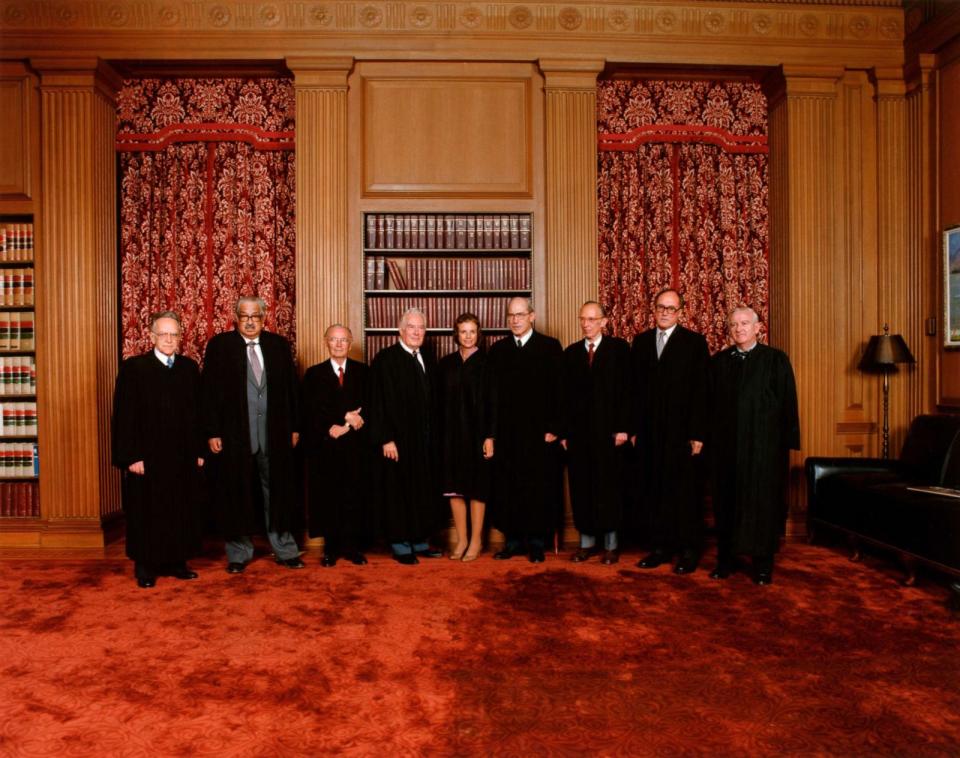
Historians consider her one of the most consequential women in American history.
"The law was a male thing. The Supreme Court was a male place. Merely her presence there as a woman changed everything," said Evan Thomas, O'Connor's official biographer.
"She was a feminist, but she didn't call herself that," said Thomas. "She knew that to get along with these men who were waiting for her to fail, she had to be careful, but at the same time tough and strong. It was a hard balance to strike, but she did."
MORE: July 7, 1981: President Reagan nominates Sandra Day O'Connor to the Supreme Court
Republican President Ronald Reagan appointed O'Connor in 1981 as, "truly a person for all seasons," a constitutional conservative who he believed would both solidify the court's right-leaning majority and fulfill a campaign promise to put a qualified woman on the bench.
"The proper role of the judiciary is one of interpreting and applying the law -- not making it," O'Connor, then 51, said during her confirmation hearing. She was confirmed by the Senate 99-0.
"When she arrived, there were no women's bathrooms near the justices' conference room, and they had just removed the plaques that said 'Mr. Justice' from the offices -- but she adapted quickly and confidently," said Kate Shaw, ABC News Supreme Court analyst and former clerk for Justice John Paul Stevens. "She came to be beloved by her colleagues."
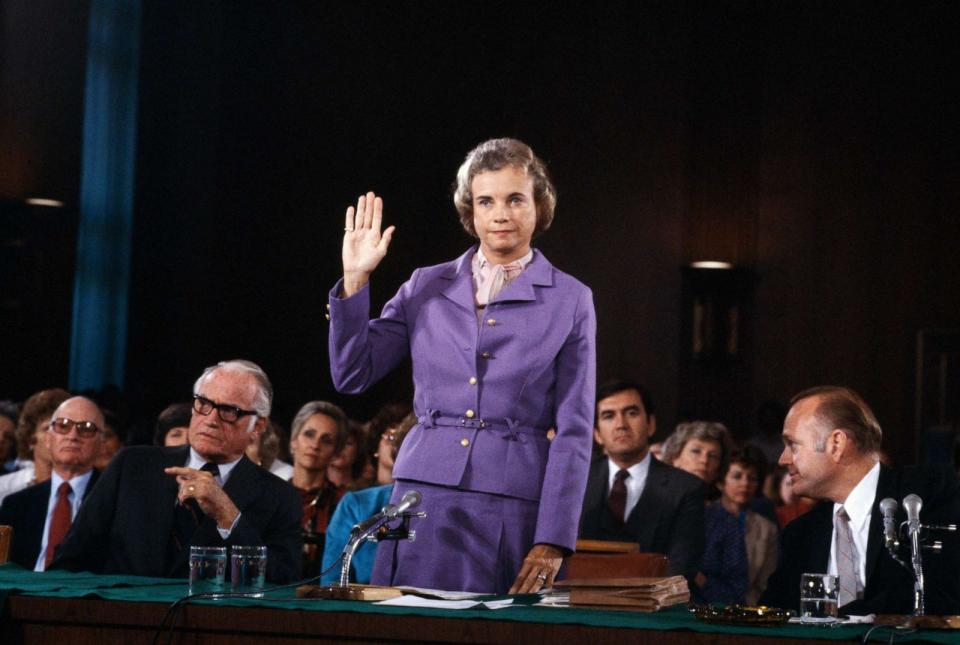
While few considered her an ideologue, O'Connor was a loyal Republican, embracing the values of smaller government, self-reliance and social conservatism that the party of the 1980s represented.
"She came from the country-club wing of the party," said author Linda Hirshman, whose book "Sisters in Law" chronicles the relationship between O'Connor and Justice Ruth Bader Ginsburg. "She had a libertarian streak. But Sandra Day O'Connor did not have a clear philosophy."
O'Connor famously demonstrated an independence and pragmatism that friends and associates say reflected her scrappy upbringing on her family's beloved Lazy-B ranch in southeastern Arizona.
For more than two decades, O'Connor was often the decisive vote on a narrowly divided court. She wrote landmark opinions on abortion and affirmative action, and is credited by some -- bitterly blamed by others -- for helping Republican George W. Bush secure the presidency in the contested 2000 election.
"It was a hard decision to make," O'Connor told CNN in 2010 of her vote to block additional Florida ballot recounts sought by Democratic nominee Al Gore. "But I do know this. There were at least three separate recounts of the votes, the ballots, in the four counties where it was challenged. In not one of the recounts would the decision have changed. So I don't worry about it."
She was an ardent defender of First Amendment protections, showing particular concern for religious liberty.
"A State that makes criminal an individual's religiously motivated conduct burdens that individual's free exercise of religion in the severest manner possible," O'Connor wrote in a concurring opinion in a 1990 case from Oregon. She didn't believe the right to free exercise was absolute, but she argued the bar for states to limit religious activity was high.
In a narrowly decided case in 1984, O'Connor joined the court majority in upholding a Rhode Island town's creche display as part of its holiday decor.
"The display of the creche likewise serves a secular purpose -- celebration of a public holiday with traditional symbols. It cannot fairly be understood to convey a message of government endorsement of religion," she wrote in a concurring opinion, proposing an "endorsement test" that the court would use widely in years that followed.
Yet over time, many conservatives would be disappointed with O'Connor.
In what was then the most important challenge to abortion rights since Roe v. Wade, O'Connor was the decisive vote in a case affirming those rights. In 1992, she joined the majority of justices to strike down a Pennsylvania law that required a woman to notify her husband if she wanted to have an abortion.
"There are millions of women in this country who are the victims of regular physical and psychological abuse at the hands of their husbands," O'Connor and her co-authors wrote in the majority opinion for Planned Parenthood v. Casey. "Should these women become pregnant, they may have very good reasons for not wishing to inform their husbands of their decision to obtain an abortion."
O'Connor had said she opposed abortion as a personal matter, but in Casey she explained that the notification requirement posed a "substantial obstacle in the path of a woman seeking an abortion before the fetus attains viability," or an "undue burden."
The standard remained the Supreme Court's constitutional litmus test for state regulations related to the procedure until the court's 2022 decision in Dobbs v. Jackson Women's Health Organization overturned Roe v. Wade and the litmus test in Planned Parenthood v. Casey.
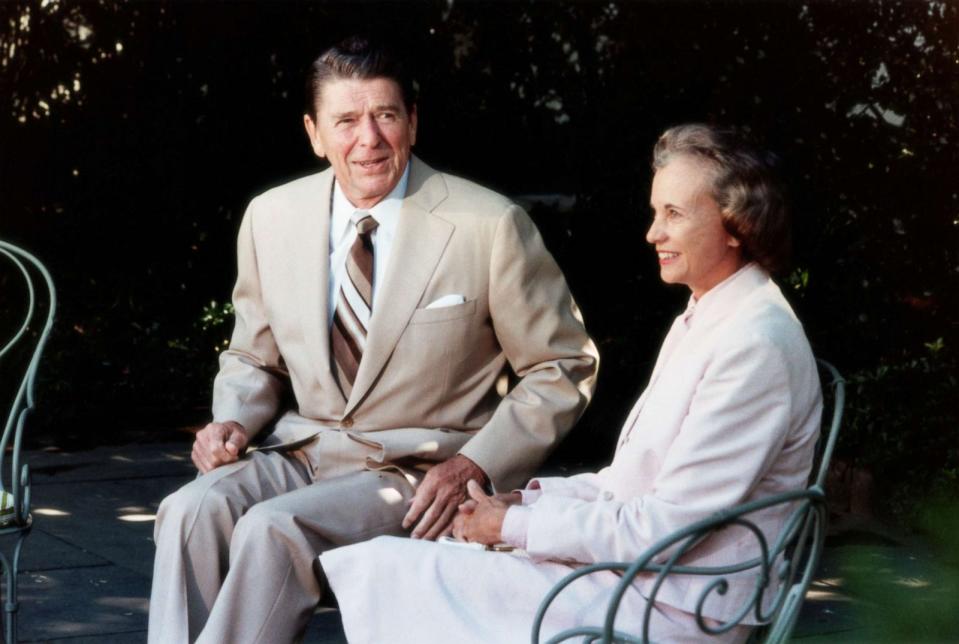
On the equally fraught issue of race in college admissions, O'Connor was similarly torn. She had concerns about the practice, but in 2003 joined with the court's liberals to preserve race-conscious admissions at the University of Michigan Law School.
"In the context of its individualized inquiry into the possible diversity contributions of all applicants, the Law School's race-conscious admissions program does not unduly harm nonminority applicants," O'Connor wrote in the opinion on Grutter v. Bollinger.
At the same time, she signaled that affirmative action should be temporary, writing, "We expect that 25 years from now, the use of racial preferences will no longer be necessary to further the interest approved today."
She believed in the constitutionality of the death penalty, but backed limits on who states could execute, especially the mentally ill.
''If statistics are any indication, the system may well be allowing some innocent defendants to be executed," she said in a speech in 2001.
Like much of the country during her tenure, she underwent a transformation on gay rights. Early on, O'Connor voted to uphold a Georgia law that made sodomy illegal. Two decades later, she took the other side in a similar case from Texas, arguing that the state's "bare desire to harm" homosexuals violated the 14th Amendment's Equal Protection Clause.
"The statute at issue here makes sodomy a crime only if a person engages in deviate sexual intercourse with another individual of the same sex. Sodomy between opposite-sex partners, however, is not a crime in Texas," O'Connor wrote in a concurring opinion in Lawrence v. Texas. "Texas' sodomy law brands all homosexuals as criminals, thereby making it more difficult for homosexuals to be treated in the same manner as everyone else."
A decade later, in 2013, retired Justice O'Connor officiated the wedding of a same-sex couple at the Supreme Court.
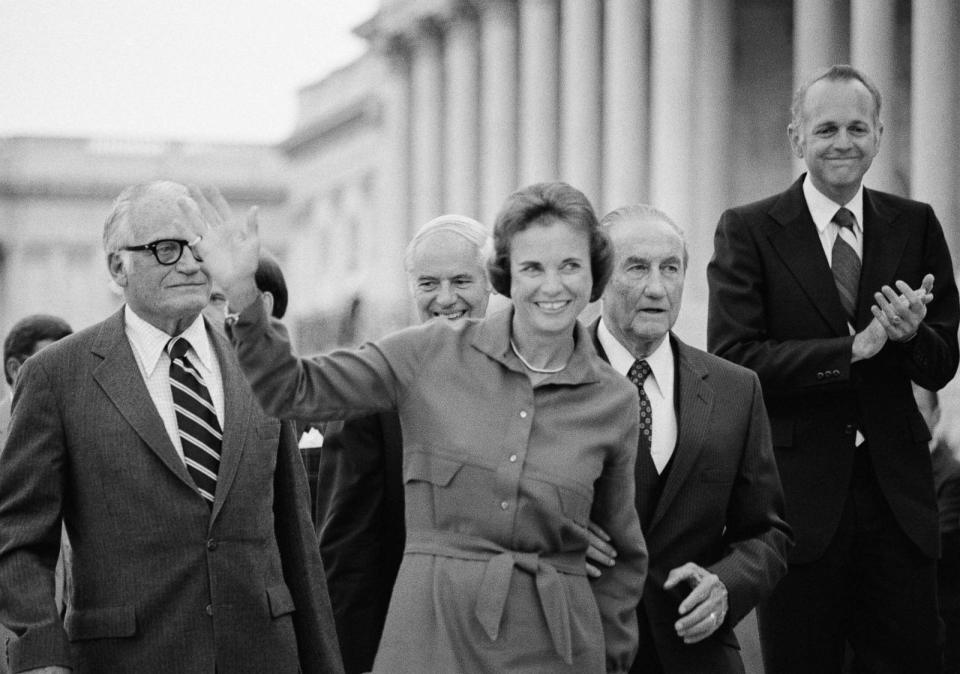
Some civil rights advocates wished O'Connor had done more to advance their cause.
"Her legacy as the perfect first is the strongest part of her legacy. Her decisions in the many Supreme Court matters where she was the critical 5th vote, are not the strongest part of her legacy," said Hirshman. "Many of them were wrong. She gave the critical 5th vote to the conservatives in a number of cases where she did harm, actually."
(MORE: O'Connor Warns Kagan on 'Dreadful' Hearings)
Particularly troubling to some women's rights advocates was her vote in the 1986 case Meritor Savings Bank v. Vinson. The court unanimously affirmed the plaintiffs claim of sex discrimination in the workplace, but stopped short -- thanks to O'Connor's vote -- in allowing the company to be held liable for the misconduct of its employees.
"O'Connor and Ginsburg, in the years they overlapped, came out with the same ruling on cases involving women 95 percent of the time. However, you will see that often she rules for the woman litigant in the case but restricts the ruling so narrowly that in real life it doesn't really help women a lot," said Hirshman.
Later in her career, O'Connor became particularly impassioned and concerned about the role of money in politics, especially in judicial elections.
"It has the effect of turning judges into these politically-elected figures in arms races, if you will, by people with the means to support them," she said after retiring.
She joined with Justice John Paul Stevens on a 2003 opinion upholding a landmark overhaul of campaign finance law -- the Bipartisan Campaign Reform Act, also known as the McCain-Feingold Act after the two senators who wrote the bill.
The law imposed first-ever limits on soft money contributions to the political parties and candidates by unions and corporations. But the court's decision wouldn't hold for long. Five years after her retirement, the court reversed in Citizens United v. Federal Election Commission.
"If both sides unleash their campaign spending monies without restrictions, then I think mutually-assured destruction is the most likely outcome," O'Connor lamented in a speech at Georgetown University in 2010.
For as much influence as she had as a justice in the middle of a divided court, she long rejected the notion that she was ever a "swing vote."
"I don't think any justice -- and I hope I was not one," she told NPR in 2013, "would swing back and forth and just try to make decisions not based on legal principles but on where you thought the direction should go, and so I never liked that term."
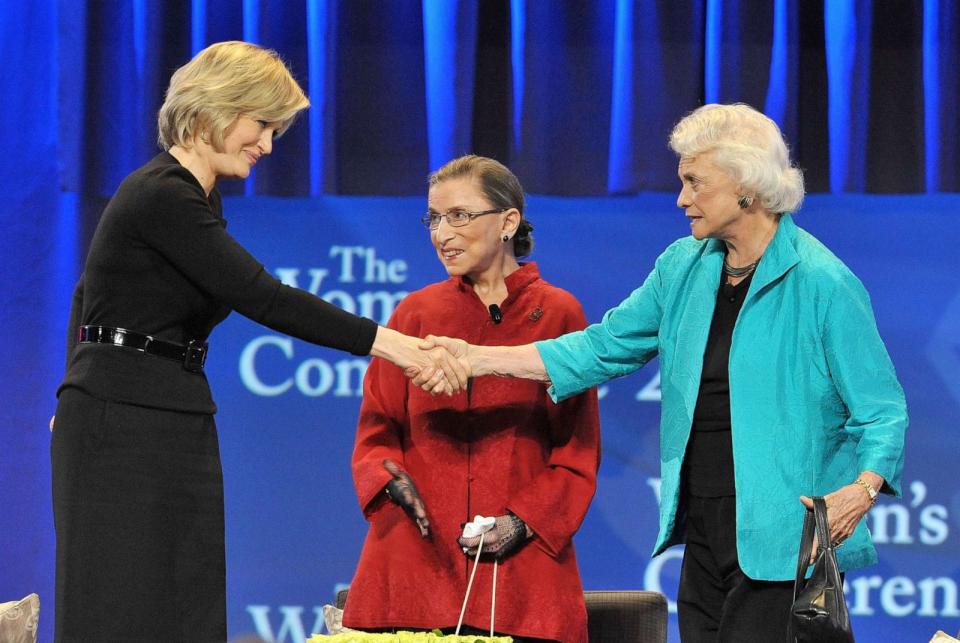
Born in El Paso, Texas, in the midst of the Great Depression, O'Connor came of age on her family's beloved ranch in southeast Arizona. She rode horseback, herded cattle, tended to windmills and prayed for rain.
"It was the best life," she once said of her upbringing.
As the country moved past World War II, O'Connor enrolled at Stanford University -- finishing her undergraduate and law degrees in just six years.
She graduated at the top of her class, but for more than a dozen years struggled to get a job as a private attorney. Major American firms were largely closed to women lawyers at the time, some offering her secretarial positions as consolation. She declined.
O'Connor's first job out of school was as Deputy County Attorney of San Mateo, California. Later, she moved to Germany with her husband, John, who was a military lawyer, and worked as a civilian attorney in the U.S. Army.
Back stateside, O'Connor hung out her own shingle for private practice in Phoenix while raising her family of three boys -- Scott, Jay and Brian. In 1969, she turned to politics, accepting an appointment to the Arizona state Senate. She was re-elected twice and chosen by her peers to serve as Republican majority leader -- the first woman to lead the upper chamber in any statehouse nationwide.
In 1974, O'Connor turned back to the law, running successfully for the Maricopa County Superior Court. Five years later, she was appointed to the Arizona Court of Appeals. It was from there that she caught the eye of the Reagan White House.
"It is challenging to be a 'first,'" O'Connor wrote in her 2013 history of the Supreme Court.
"The first woman on the Court was carefully scrutinized by the press, the government, the lawyers, and the public," she wrote. "It is not always comfortable to be the object of so much attention. But the appointment of a woman to the Court opened countless doors to women all across the country. For that I am grateful."
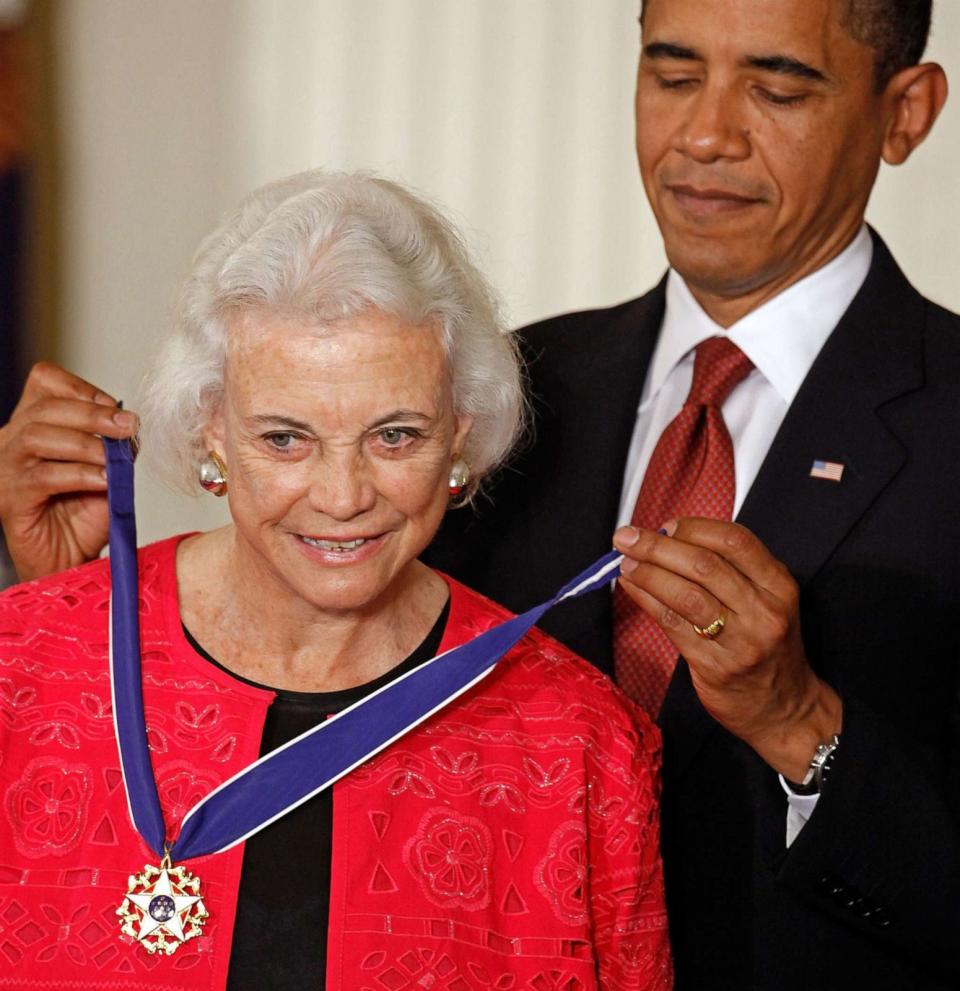
In a simple letter to President George W. Bush in July 2005, O'Connor announced her decision to step down. Her husband John -- the love of her life -- had been diagnosed with Alzheimer's and required her care.
"I will leave it with enormous respect for the integrity of the Court and its role under our Constitutional structure," she wrote.

The retired justice remained an active voice in the legal world and was staunch advocate for civics education in America's schools. She founded iCivics, a free online platform for interactive learning about U.S. government and citizenship.
"iCivics is my most important legacy," O'Connor says in a video on the site. "I want students to learn how their government works and how, in essence, they're part of what makes it function."
The program has been used by nearly 200,000 teachers to reach more than 5 million students in all 50 states, according to the iCivics website.
(MORE: Sandra Day O'Connor on Civics Education)
"She said that meant more to her than being a Supreme Court justice. Her friends would say, 'Come on,'" said her biographer Thomas. "But she meant it."
In 2009, President Barack Obama awarded O'Connor the nation's highest civilian honor, the Presidential Medal of Freedom.
MORE: Sandra Day O'Connor: Obama Should Get to Choose Scalia's Replacement
"She made a mighty fine justice of the U.S. Supreme Court. A judge and Arizona legislator, cancer survivor, child of the Texas plains, Sandra Day O'Connor is like the pilgrim in the poem she sometimes quotes, who has forged a new trail and built a bridge behind her for all young women to follow," Obama said.
At 88 years old, faced with "the beginning stages of dementia, probably Alzheimer's disease," O'Connor released a public letter announcing her intention to withdraw from public life in 2018.
MORE: Former Supreme Court Justice Sandra Day O'Connor announces dementia diagnosis
"While the final chapter of my life with dementia may be trying, nothing has diminished my gratitude and deep appreciation for the countless blessings in my life," she wrote. "How fortunate I feel to be an American and to have been presented with the remarkable opportunities available to the citizens of our country. As a young cowgirl from the Arizona desert, I never could have imagined that one day I would become the first woman justice on the U.S. Supreme Court."
Ginsburg, the second woman justice who joined O'Connor on the bench 12 years after she was seated, hailed O'Connor for making the inclusion of women on the federal bench "no longer extraordinary, but entirely expectable."
In his public farewell to her, Chief Justice John Roberts summed up O'Connor as a "towering figure in the history of the United States, and indeed the world."
Sandra Day O'Connor, 1st woman on Supreme Court, dies at 93 originally appeared on abcnews.go.com

